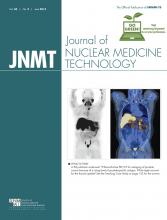Abstract
Maffucci syndrome is a rare condition with multiple enchondromas and hemangiomas. Fewer than 200 cases have been reported in the United States. There is a high predilection for neoplastic changes, and PET/CT has an important role in detecting these changes.
Maffucci syndrome is a rare condition with multiple enchondromas and hemangiomas. Fewer than 200 cases have been reported in the United States. To our knowledge, this is only the second case report to show the appearance of Maffucci syndrome on PET/CT scans.
CASE REPORT
A 45-y-old man with a history of Maffucci syndrome underwent right-knee radiography because of knee pain (Fig. 1). Restaging 18F-FDG PET/CT for chondrosarcoma was ordered. Sixty minutes after intravenous administration of 612.72 MBq (16.56 mCi) of 18F-FDG, sequential unenhanced CT and then PET images were acquired. The PET/CT scan showed multiple osseous lesions similar in appearance to one another (Fig. 2). In such a case, a benign etiology, such as an enchondroma, would be highly favored over an aggressive tumor. Also, throughout the subcutaneous tissues there were multiple soft-tissue nodular densities lacking abnormal 18F-FDG uptake, favoring the benign etiology hemangioma (Fig. 3). Several of the subcutaneous nodules on the right side of the abdominal wall had punctate calcifications. These represent phleboliths, a typical finding in hemangioma. Abnormal 18F-FDG uptake within a subcutaneous nodule would raise concern about malignant transformation to hemangiosarcoma.
Right-knee radiograph demonstrating marked deformity of distal femur and proximal tibia and fibula. There are expansile lucent lesions with cortical thinning and calcified matrix that are consistent with chondroid-type lesions. Presence of multiple chondroid lesions is consistent with Maffucci syndrome in patients who have characteristic bluish subcutaneous hemangiomas on physical examination.
18F-FDG PET/CT scan demonstrating only mild 18F-FDG uptake in right hemipelvis. Maximum standardized uptake value is 1.8, similar to surrounding osseous structure.
18F-FDG PET/CT scan demonstrating multiple soft-tissue nodular densities throughout subcutaneous tissues (phleboliths).
DISCUSSION
Maffucci syndrome is a rare condition with multiple enchondromas and hemangiomas. Fewer than 200 cases have been reported in the United States (1). If a patient has multiple enchondromas without hemangiomas, the condition is known as Ollier disease. Maffucci syndrome is a congenital nonhereditary condition. It usually presents before the onset of puberty and is often located within the long bones. An estimated 25%–30% of enchondromas develop into chondrosarcoma (2,3).
The average age for neoplastic change from enchondroma to chondrosarcoma in Maffucci syndrome patients is 40 y. There is also an increased risk of malignant transformation of hemangiomas into hemangiosarcomas and hemangioendotheliomas (4). A maximum standardized uptake value of more than 2.0 can be used to distinguish benign from malignant cartilaginous tumors with 90.9% sensitivity, 100% specificity, and 96.6% accuracy (5). Maffucci syndrome is often distinguished from Ollier disease by physical examination. The presence of red or purplish growths in the skin would be consistent with a hemangioma. Affected individuals can also have lymphangiomas.
CONCLUSION
Maffucci syndrome is a rare congenital nonhereditary condition. There is a high predilection for neoplastic changes, and PET/CT has an important role in detecting these changes.
DISCLOSURE
No potential conflict of interest relevant to this article was reported.
Footnotes
-
Published online Dec. 23, 2014.
REFERENCES
- Received for publication July 30, 2014.
- Accepted for publication October 9, 2014.










